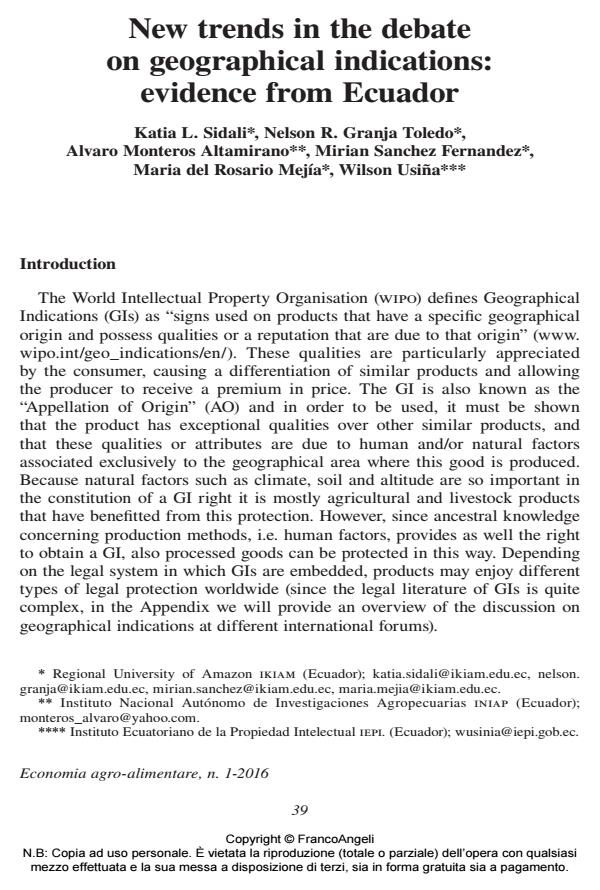New trends in the debate on geographical indications: evidence from Ecuador
Journal title ECONOMIA AGRO-ALIMENTARE
Author/s Katia L. Sidali, Nelson R. Granja Toledo, Alvaro Monteros Altamirano, Mirian Sanchez Fernandez, Maria del Rosario Mejía, Wilson Usina
Publishing Year 2016 Issue 2016/1
Language English Pages 14 P. 39-52 File size 111 KB
DOI 10.3280/ECAG2016-001003
DOI is like a bar code for intellectual property: to have more infomation
click here
Below, you can see the article first page
If you want to buy this article in PDF format, you can do it, following the instructions to buy download credits

FrancoAngeli is member of Publishers International Linking Association, Inc (PILA), a not-for-profit association which run the CrossRef service enabling links to and from online scholarly content.
Geographical Indications (GIs) are names of regions, specific places or, in exceptional cases, countries, used to describe an agricultural product or a foodstuff (EC 510/2006, Art. 2). They have received much attention in recent years not only at the European level, where they stem from, but also at different international forums such as at the World Trade Organization (wto). Being a particular form of intellectual property, these certification schemes have the potential to be applied also to non-agrifood commodities or even services. Furthermore, due to the grave menace of biodiversity loss caused by globalization, GIs could serve as a tool to promote biodiversity if linked to plant varieties or animal species in danger of disappearance. It seems that at European level these issues are gathering momentum. For this reason, the purpose of this paper is to support new interpretations regarding GI legislation. In the remainder of this paper, the authors will present a short description of GIs as they have been discussed at different international forums. Also, the innovative implementation of GIs in Ecuador will be illustrated by means of two examples: the Sombrero of Montecristi and the cacao Nacional Arriba. Based on these examples we trace possible scenarios of GI implementation in a particular type of service economy such as food tourism. In the final part, some conclusions will be presented.
Keywords: Geographical Indications, local culture, biodiversity, Ecuador, niche products, extension, GI protection
Jel codes: D23, D18, P14
- Patrimonios alimentarios en América Latina María Gabriela Zurita-Benavides, Anne Schwarz, Álvaro Monteros Altamirano, María Cristina Peñuela-Mora, pp.59 (ISBN:9786124358081)
Katia L. Sidali, Nelson R. Granja Toledo, Alvaro Monteros Altamirano, Mirian Sanchez Fernandez, Maria del Rosario Mejía, Wilson Usina, New trends in the debate on geographical indications: evidence from Ecuador in "ECONOMIA AGRO-ALIMENTARE" 1/2016, pp 39-52, DOI: 10.3280/ECAG2016-001003